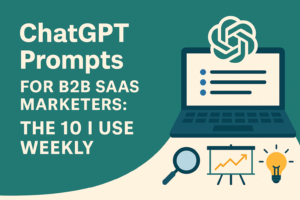Standing out in the crowded SaaS landscape is not easy. Every brand is competing for the attention of potential buyers, and traditional tactics often fall short. Modern buyers are more discerning, consuming multiple pieces of content before they even consider talking to a sales team. According to a study by Demand Gen, B2B buyers review an average of 13 or more pieces of content during their research phase. This means SaaS marketers need to create content that is not just informative but also engaging, diverse, and strategically designed to capture attention at the top of the funnel (ToFu).
The good news? You don’t need to reinvent the wheel. By focusing on a mix of proven content formats blogs, videos, webinars, podcasts, and more you can meet your audience where they are and build the awareness your brand needs. In this blog, we’ll explore seven content formats that have been consistently effective in driving brand visibility and early engagement for SaaS companies. Each format is backed by examples, actionable tips, and real-world data to help you craft a winning content strategy.
Why Content Variety is Key to SaaS Awareness
The SaaS buyer journey is complex. Prospects often start with general awareness content, looking for answers to their challenges before narrowing down potential solutions. If your content is limited to one format say, just blogs you risk missing the opportunity to connect with audiences who prefer visual, interactive, or audio content.
Content variety not only increases the number of touchpoints but also boosts your chances of being discovered through different channels, including search engines, social media, and even community-driven platforms. For example, a single blog post can be repurposed into a video tutorial, an infographic, and a podcast episode, reaching different segments of your audience.
A HubSpot report revealed that companies using multiple content formats saw a 40% increase in user engagement compared to those relying on a single medium. This underscores the importance of diversifying your content strategy to maximize visibility and awareness.
1. Blogs and Educational Articles
Blogs remain the cornerstone of SaaS content marketing. Well-researched and informative blog articles can help your brand rank in search results, answer buyer questions, and establish thought leadership. The key to success lies in creating blogs that go beyond surface-level information.
For example, instead of writing generic articles like “What Is SaaS?”, create detailed guides that address specific pain points: “How SaaS Example Software Simplifies XXX” or “10 Steps to Improve Your SaaS Management Process.” Long-form educational blogs (1,500+ words) perform particularly well because they offer comprehensive answers, which both readers and search engines value.
Tips to make blogs more effective:
- Focus on ToFu topics such as industry trends, common challenges, and beginner guides.
- Incorporate actionable takeaways and examples from real SaaS brands.
- Optimize for featured snippets by using concise answers, numbered lists, and clear headings.
- Add TL;DR summaries at the top for busy readers.
With 81% of B2B marketers stating that blogs generate more leads than other content formats, investing in a strong blog strategy is a must for SaaS awareness.
2. Video Content (Explainers & Product Walkthroughs)
Video content is dominating digital marketing, and for good reason. It’s easier for audiences to consume and retain information from videos compared to text. For SaaS companies, videos are a powerful tool for explaining complex solutions in a clear, engaging way.
Explainer videos, product walkthroughs, and even short-form content (such as 60-second LinkedIn clips) are particularly effective for ToFu awareness. According to Wyzowl’s State of Video Marketing report, 66% of marketers say videos help generate more qualified leads each year. SaaS companies like Slack and Zoom use product explainer videos not just to demonstrate features but also to showcase real-life use cases.
Best practices for video content:
- Keep videos short and focused (2–3 minutes for explainers).
- Use captions and graphics to highlight key messages.
- Share videos across multiple platforms, including YouTube, LinkedIn, and your website.
- Create a content mix of demos, expert interviews, and quick tutorials.
Videos not only improve engagement but can also boost time spent on your site an important ranking signal for search engines.
3. Infographics and Visual Data Content
Infographics combine visuals and data to make complex topics easy to understand. For SaaS products that involve technical processes or data-driven insights, infographics are an excellent way to simplify information while making it shareable.
For example, an infographic titled “The SaaS Buyer’s Journey in 5 Stages” can be embedded in blogs, shared on social media, or even turned into a downloadable asset. Infographics also help earn backlinks, as other websites and blogs are more likely to reference a visually compelling piece of data.
Tips for creating impactful infographics:
- Focus on high-value data or step-by-step processes.
- Use clean, professional designs with your brand’s colors.
- Include statistics from credible sources to build trust.
- Promote infographics through social platforms and email campaigns.
Studies show that infographics are 30 times more likely to be read in full compared to text-only content, making them a must-have format for driving awareness.
4. Interactive Content (Quizzes, Calculators, Polls)
Interactive content engages users in a way that static content can’t. Whether it’s a quiz that helps users assess their needs or a calculator that shows potential ROI, interactive content provides value while capturing attention.
For SaaS brands, ROI calculators, pricing estimators, or readiness quizzes can be highly effective lead magnets.
Why interactive content works:
- It increases time spent on your website.
- It creates a personalized experience for users.
- It encourages social sharing and engagement.
According to Demand Metric, interactive content generates twice the engagement compared to static content. It’s also more likely to be remembered, which is crucial for top-of-funnel campaigns.
5. Webinars and Live Sessions
Webinars allow SaaS companies to connect with audiences in real time, delivering value through expert insights, product walkthroughs, or industry discussions. Live sessions, whether on LinkedIn or Zoom, provide an opportunity for two-way interaction that builds trust and authority.
Successful SaaS webinars focus on educating rather than selling. For example, HubSpot often hosts webinars on marketing trends, offering practical advice while subtly showcasing their tools.
Webinar tips for better impact:
- Keep sessions under 45 minutes with time for Q&A.
- Feature industry experts or customers as speakers.
- Record and repurpose webinars into short video clips or blog summaries.
Research shows that 73% of B2B marketers consider webinars to be one of the most effective methods for generating quality leads. This makes webinars a versatile format for building both awareness and trust.
6. Case Studies and Customer Stories
Case studies are powerful trust-building tools. At the awareness stage, prospects want to see how your SaaS solution has helped others like them. A well-structured case study tells a story of a customer’s challenge, the solution implemented, and the measurable results achieved.
Beyond traditional PDFs, short customer success stories can be shared as blog posts, videos, or social media highlights. These stories provide proof that your product delivers real value.
Best practices for case studies:
- Focus on a clear problem-solution-results structure.
- Use data points to highlight success (e.g., “Increased productivity by 40%”).
- Add customer quotes or testimonials to enhance credibility.
Case studies not only educate but also position your brand as a trusted partner that understands real-world challenges.
7. Podcasts and Audio Content
Podcasts are gaining popularity as a medium for B2B content, offering a convenient way for audiences to consume insights during commutes or workouts. A podcast series can position your brand as a thought leader, especially if you invite industry experts or discuss emerging SaaS trends.
For example, SaaStr’s podcast has become a go-to resource for SaaS founders and marketers, blending expert interviews with actionable advice.
Tips for launching a SaaS podcast:
- Keep episodes between 20–30 minutes.
- Choose recurring themes relevant to your target audience.
- Promote episodes through your blog, newsletter, and LinkedIn.
- Repurpose podcast content into blog posts and social snippets.
With the growing appetite for audio content, podcasts offer a fresh way to reach new audiences and strengthen brand recall.
Choosing the Right Format for Your SaaS Brand
While all seven content formats are effective, you don’t need to adopt them all at once. Start by identifying your audience’s preferences and your team’s capabilities. For example, if you have strong writing resources, focus on blogs and infographics first. If you have the bandwidth for creative production, experiment with videos and interactive tools.
A hybrid approach often works best. For instance, a single educational blog can be converted into a short video summary, a downloadable infographic, and a LinkedIn carousel. This not only saves time but also multiplies your reach across different platforms.
Next Steps: Putting These Content Formats into Action
Building brand awareness for a SaaS business is all about creating valuable, memorable, and shareable content. By incorporating a mix of formats blogs, videos, infographics, interactive tools, webinars, case studies, and podcasts you can engage buyers at every touchpoint of their journey. The SaaS brands that win are those that focus on educating, not just selling. Start by picking two or three formats that align with your audience’s needs and double down on delivering quality. Over time, you’ll not only boost visibility but also build a trusted presence in your niche.
Key FAQs on SaaS Content Strategies and Formats
1. What is SaaS content marketing?
SaaS content marketing is the strategic creation and distribution of valuable content such as blogs, videos, and case studies to attract, engage, and educate potential users about a SaaS product, with the goal of building trust and driving conversions.
2. Which content format works best for SaaS startups?
Blogs and educational content are the best starting points for SaaS startups. They help establish domain authority and attract organic traffic with relatively low production costs.
3. How often should SaaS brands publish new content?
Consistency is key. Publishing at least one high-quality blog or content piece per week is ideal for building momentum, but quality should never be compromised for quantity.
4. Do webinars or blogs drive more awareness?
Both are effective, but blogs help with long-term discoverability via SEO, while webinars build real-time engagement and trust.
5. How do I measure the success of these content formats?
Key metrics include organic traffic, time on page, engagement rate, social shares, webinar attendance, and leads generated.
6. Can small SaaS teams create all these content types?
Yes, but prioritize. Start with blogs and repurpose them into videos or infographics. Over time, expand into other formats as your resources grow.

vetrivel is an accomplished SEO and digital marketing expert with 5 plus years of experience. dedicated to providing readers with informative and engaging content.




